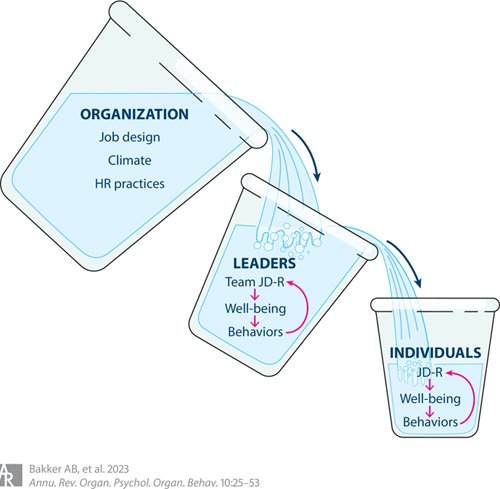
Build Knowledge - A Toolkit for School Systems to Advance Comprehensive School Employee Wellness
- Brandon Stratford
- Bonnie Solomon
- Joy Thompson
- Devan O’Toole
- Kaylor Garcia
- Kajol Surani
- Michael Martinez
- Sarah Her
Step 1: Build Knowledge
This step provides information and tools to help planning teams build knowledge in three key areas:
- A Comprehensive School Employee Wellness Framework
- The Role of School Systems in Supporting School Employee Wellness
- Achieving Wellness for All Employees
1. A Comprehensive School Employee Wellness Framework
This framework is informed by research on school employee wellness, health equity, and implementation science.

About the framework
This framework illustrates employee wellness-enhancing processes within and among the school system (blue), individual school (grey), and employee (purple) contexts.
The curved arrows along the top reflect school systems’ and schools’ roles in distributing resources among schools and employees and in setting/enforcing policies fairly. The curved arrows along the bottom reflect the role of data in guiding efforts to advance employee wellness at the school and school system levels; they also emphasize the importance of disaggregating data to ensure that efforts prioritize the needs of schools and employees experiencing the greatest barriers to wellness.
The purple circle on the far right represents the six domains of school employee wellness. It reflects employees’ agency with respect to their own wellness and the actions they take to advocate for themselves, their colleagues, and their students. The purple icons to the left of this circle emphasize the diversity of school employee positions.
The text across the bottom of the framework draws attention to how communities influence school employee wellness, highlighting the role of institutional and interpersonal discrimination in unfairly restricting access to wellness-promoting assets for members of marginalized communities.
Click on each term below for a definition:
2. The Role of School Systems in Supporting School Employee Wellness
School systems have a unique role in directly—and indirectly—promoting school employee wellness through setting and enforcing policies that influence wellness and distributing resources to increase access to programs that promote wellness and/or reduce job stressors. School system leaders should ensure that policies and resources benefit all employees, especially those with the greatest needs. When exploring school system strategies to address priorities, planning teams will likely need to consider a mix of policy, program, and practice solutions (for example, a teacher retention strategy from Philadelphia Public Schools).
Policies: School systems can influence working conditions—and employee wellness—by setting and enforcing policies that establish systemwide expectations and dictate how resources are distributed. For example, districts often set benefits such as parental leave and allocate resources such as facilities budgets—both of which are linked to employee wellness.
Programs: School systems can establish programs, such as principal leadership training or tuition/certification reimbursement programs, that promote employee wellness. Some programs require significant resources to implement, while others can be up and running relatively quickly with minimal investment. Employees who participate in programs stand to benefit most directly from them, so systems should monitor who participates to ensure that programs are inclusive and participation is equitable. This report on the Colorado Retaining Teachers Grant Program describes some strategies that participating school districts implemented, including teacher induction and mentoring programs.
Practices: School systems’ practices influence working conditions and, ultimately, employee wellness. This toolkit distinguishes practices from policies by establishing policies as official rules (i.e., codified) and practices as noncodified norms. For example, Aurora Public Schools collects this survey to learn about the experiences of administrative technical/professional and classified staff.
Assess Readiness to Make and Sustain Change includes questions to assess how well-positioned a school system is to make changes to policies, programs, and practices to advance school employee wellness. The Take Action section includes guidance on using data to set priorities.
The tools in this section include examples of policies, programs, and practices to advance employee wellness. Given that policies, programs, and practices do not always have the same impact on all employees, planning teams should ensure that priority strategies are implemented with an eye toward achieving equity. For example, seniority-based layoff policies disproportionately impact employees of color due to systemic barriers that have excluded Black, Hispanic, and Indigenous people from employment as educators and school administrators. See the Equity and Inclusion on Planning Processes section for more guidance on centering equity.

Tools you can use
The resources below include practical guidance for implementing a variety of policies, programs, and practices to advance school employee wellness. Some resources are general while others focus on a specific group of employees.
Reducing job stressors
 The Job Demands and Resources (JD-R) Model describes employee wellness as a balance of workplace demands (i.e., expectations, responsibilities, etc.) and resources (i.e., materials, training, etc.). While demands are a normal part of most jobs, a workplace in which demands and resources are out of balance is likely to diminish employee wellness and result in job stress. The image to the right demonstrates how organizational policies, programs, and practices have cascading influences on the well-being of individual employees. School systems can have both direct impacts (e.g., establishing standards, equitably distributing resources, etc.) and indirect impacts (e.g., supporting school leaders) on reducing –or exacerbating—job stressors for employees.
The Job Demands and Resources (JD-R) Model describes employee wellness as a balance of workplace demands (i.e., expectations, responsibilities, etc.) and resources (i.e., materials, training, etc.). While demands are a normal part of most jobs, a workplace in which demands and resources are out of balance is likely to diminish employee wellness and result in job stress. The image to the right demonstrates how organizational policies, programs, and practices have cascading influences on the well-being of individual employees. School systems can have both direct impacts (e.g., establishing standards, equitably distributing resources, etc.) and indirect impacts (e.g., supporting school leaders) on reducing –or exacerbating—job stressors for employees.
School systems should consider how policies, programs, and practices either reduce or create job stressors—especially for particular schools or groups of employees. Planning teams should hold frank discussions with school employees who reflect the workforce (with respect to positions, tenure, and sociodemographic characteristics) to identify creative strategies to reduce job stressors for all employees, but especially those experiencing the most stressors.
See the Establish a Diverse Team and Equity and Inclusion on Planning Teams sections of the toolkit for tips on creating the sort of environment that can foster frank discussions about how to meet all employees’ needs. Planning teams should keep in mind that sometimes the best intervention is to reduce or remove unhelpful or low-priority policies, programs, and practices.
Quick win strategies to get started
Quick wins are strategies that can be implemented relatively quickly with minimal effort and/or resources; whether a strategy would be considered a quick win varies based on local circumstances and capacity (see the Assess Readiness to Make and Sustain Change section of this toolkit). However, practices such as yoga sessions, mindfulness training, and physical activity challenges may be quick wins that can benefit participants relatively quickly while building support and maintaining motivation for longer-term strategies. And, while quick wins are important, they cannot replace longer-term investments in changes to school system policies and resource allocation.
Long-term strategies to make sustainable change
The structural changes necessary to achieve equitable and sustainable improvements in school employee wellness—such as establishing equitable school leadership pipelines and modernizing school facilities—are likely to require long-term investments in order to gain buy-in and promote sustainability. However, planning teams will likely find that they can leverage existing efforts. For example, most school systems have employee recruitment and retention plans, many of which focus on policies, programs, and practices intended to attract and support a diverse workforce (see the Tools You Can Use above for examples). Investing in long-term strategies presents an opportunity to better align existing initiatives that influence employee wellness while also using data to identify additional structural barriers that require attention. This worksheet can facilitate a review of school district policies.
3. Achieving Wellness for All Employees

Efforts to achieve equitable school employee wellness should not be the work of a single person. Rather, these efforts should be led by a planning team that reflects school system employees with respect to positions, tenure, and sociodemographic characteristics. This section outlines considerations for establishing the inclusive team culture required to tackle inequities, an equity-centered framework for organizing the work, and guidance on avoiding the misuse of data in ways that exacerbate inequities. The Take Action section of this toolkit provides more detailed guidance on each topic.
Equity and Inclusion on Planning Teams
To ensure that employees’ well-being is not dictated by their identity, members of groups that experience the most barriers to wellness should help plan and monitor employee wellness efforts. However, representation alone is not enough. Planning teams should reflect on whether their own practices support equitable engagement of all members. Teams should assess and address power dynamics when considering systemic barriers to wellness and avoid placing the onus on the employees who are harmed by those barriers to identify solutions or teach others about the harms those barriers cause.
Below are five dimensions of engagement that teams should reflect on periodically as they work to achieve equitable school employee wellness:
Diversity—the presence of difference. Who is/is not on the team?
Inclusivity—encouraging and embracing difference. Who is/is not heard on the team?
Equity—fair and just treatment for all. Whose needs are/are not met on the team?
Accessibility—efforts to ensure that everyone, including individuals with disabilities, can fully participate. Whose barriers to participation have/have not been addressed on the team?
Belonging—identification with a community. Who does/does not feel welcome on the team?
The resources in this section offer strategies for creating a supportive and welcoming team culture that promotes engagement and creative problem solving. See the Establish a Diverse and Inclusive Team section of this toolkit for more detailed guidance.
Tailoring Action Planning to Meet All Employees’ Needs
Planning teams should ensure that their approach to advancing school employee wellness is tailored to employees’ unique needs. Targeted universalism is one way of organizing efforts to achieve equitable school employee wellness that focuses on equity as both a process and an outcome.
Universalism refers to selecting a goal that applies to all employees. For example, a goal that states that at least 80 percent of employees should feel respected at work should apply universally—meaning that at least 80 percent of food service workers, maintenance workers, classroom teachers, paraprofessionals, etc. should report feeling respected at work.
Targeted refers to the fact that different strategies may be required to achieve a goal for each group. For example, paraprofessionals may require different supports than classroom teachers. Using the same strategy for everyone is unlikely to achieve the universal goal: Groups that face more systemic barriers to wellness are likely to require more and/or different support to achieve the goal.
A targeted universalism framework to guide school employee wellness efforts can guide planning teams toward equitable outcomes. See the Use Data to Set Priorities and Develop a Plan sections of this toolkit for more detailed guidance.
Data Availability and Analysis to Promote Equity
Using data is central to improving school employee wellness (see the Use Data to Set Priorities section of this toolkit for more detailed guidance) but planning teams should avoid misusing data in ways that exacerbate inequities. Equitable data practices recognize and are sensitive to the ways in which data have historically been owned, accessed, and used by those in positions of privilege and power to perpetuate inequities. If planning teams use data that are not representative of all school employees, or are interpreted in ways that reinforce harmful stereotypes, their decisions may fail to address the needs of marginalized groups and/or perpetuate existing inequities.
Following equitable data-use practices can help teams develop a plan that promotes equitable school employee wellness. As one example, the Massachusetts Department of Public Health’s racial equity data road map can help organizations use data to address structural racism.

Continue to Step 2 - Take Action
Continue© Copyright 2024 ChildTrendsPrivacy Statement
Newsletter SignupLinkedInThreadsYouTube